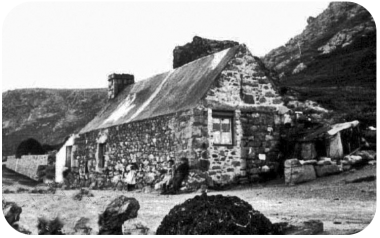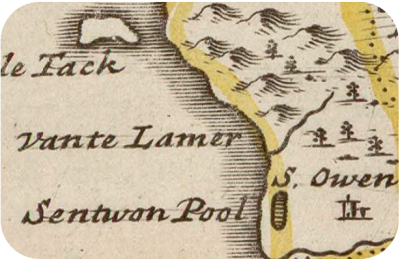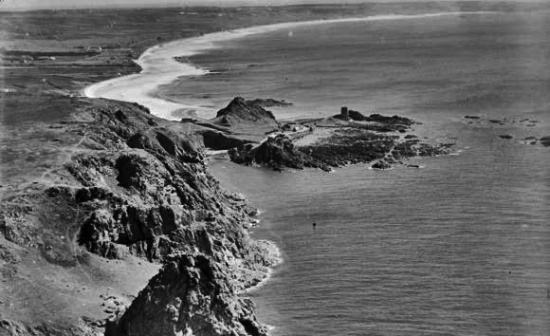Le Pulec
The precipitous cliffs of Les Landes end at the small inlet known as Le Pulec. Although the name has come to mean ‘stinking bay’ because of the smell caused by rotting vraic that gets piled up here, it actually comes from the Old Norse word for Pool. Access to the small inlet was made easier in 1858 when an access road and slipway on to the beach were built.
Vraic was especially important for the light soils of this part of the island. It could be put straight on to the land to improve the soil, or it could be left in stacks to dry. In 1710 the Seigneur of Vinchelez de Haut Manor leased a field to Jean de Carteret and Jean Le Cornu for drying vraic, for which he received two cabots of wheat and two hens a year. In order to prevent erosion of the shoreline by carts going on to the beach in the 1850s and 1860s, the States built a number of granite slipways with short flanking walls. Over the years further stretches of seawall were built until, during the Occupation, the Germans forces linked them all together behind a reinforced concrete anti-tank wall, two metres thick and six metres high.
Dominating Le Pulec to the south is the massive rock that gives the area its name, L’Etacquerel, which comes from the old Norse word for a heap or a stack of rock – stakkr. While most buildings and the haven lie in the lee of the massive rock, a small cottage called La Voûte, because of its vaulted roof, was built on the seaward side in the 1th century. A datestone in its gable is testament to the fact that Jean Hubert and Elizabeth Le Gresley were living there in 1753.
The Chamber of Commerce report of 1872 noted that the fishery here involved about 12 boats and 30 fishermen, who mainly went out for crab and lobster. Slipways had been built at either end of the haven in the mid-1860s, to allow the boats to be hauled to safety off the beach, but the report also made the recommendation that a small breakwater should be built, because boats at anchor were frequently damaged because of a lack of one. From the seaward side, access was along La Bouque - a narrow, safe passage about three-quarters of a mile long through the reefs.
It was here at L’Etacq that in the late 1820s Philip Hacquoil built three boats – all just over 30 feet (9½ metres) and about 14 or 15 tons. These were the Friends and the Dophin in 1825, and the Hope three years later. In 1831 the Dolphin, which was owned by Philip Perree and his son, was seized and condemned for smuggling.
Further to the south is an area known as La Saline, which is where salt was collected by evaporating seawater from very shallow pools. This was first mentioned in 1248. Access to the beach here was improved in 1856 when the slipway - La Montée de la Brequette - was built. Near the slip, a house was built just after the Great War, to look like an early 19th century fort, complete with loopholed walls. It took its name from the field behind it - Le Petit Fort. In recent years a modern house has been built, destroying the illusion.
Beyond La Saline the place names give a clue as to the characteristics of the area: Les Laveurs was where the waves surged up the beach washing the shingle, La Crabiére took its name from the offshore rocks where crabs were caught and, just over the parish boundary, by the southern end of St Ouen's Pond, L’Ouzière, which took its name from the English word ‘ooze’, because before the sea wall altered the make up of the beach, this area was quite muddy.
For a long time this northern half of the bay was thought to have protection enough from any attempted enemy landing from the reefs running down from L’Etacq. A French map of the island dated 1757 shows the only defensive structure in the bay was a redoubt holding four cannons, in the vicinity of La Tour Cârrée, or The Square Tower. The current building, which is more of a blockhouse with loopholes for musketry than a tower, was put up in 1778. The following year, three 24-pounder cannons - referred to as the North Battery - were placed in front of it. Today it is painted white and black on the seaward side, as a navigation mark, and since 2007 it has been part of the Jersey Heritage holiday lets scheme.
With the growing tension following the attempted landing in the bay in 1779, and the Battle of Jersey two years later, further batteries were built. Among these, close to where Lewis’s Tower now stands, was the Du Parcq Battery. Named after Jean du Parcq, the Rector of St Ouen, who, during an attempted French landing in 1779, brought down several artillery pieces to form a battery on the beach. Originally it had three small-calibre guns and two 8-pounders, but by 1787 these had been replaced by three 24-pounders on a wooden platform behind a turf rampart.
During the 1830s, following a report that highlighted the threat posed by ships carrying larger calibre guns, which could hold position beyond the reefs and bombard the coast, these batteries were replaced by three of the last Martello towers to be built in Europe – Kempt Tower, Lewis Tower and L’Etacq Tower. The work on all three was supervised by Colonel G G Lewis, the Commanding Officer of the Royal Engineers in the Island, but the actual construction was carried out by local builders.
L’Etacq Tower was demolished by the Germans in 1942 to make way for a bunker housing a 105mm coastal gun. Since 1980 this has housed Faulkener Fisheries' vivier. As it was situated on the point at L’Etacq overlooking the small haven, it was also known as Le Havre Tower. Built by John Benest in 1833 for £840, it was armed with a single 24-pounder gun set on a traversing platform on the roof, and was garrisoned by a sergeant and twelve men.
Like the other towers in the island, once Britain and France became allies in the 1850s it was allowed to fall into disrepair; the War Department actively began to get rid of them after the Great War.
Work on Lewis’s Tower started in May 1835, but the builder Jean Gruchy, stopped work in June when Philippe du Heaume, the Seigneur of the Fief of Morville and Robilliard, raised the Clameur de Haro. His claim was upheld, and he received 600 Francs compensation. Work resumed in July that year. By spring 1837 it was nearly finished, although the ground floor magazine needed to be completed, as did the water cistern.
Jean Gruchy received £780 for his work, but within two years the Royal Engineers were complaining that it was not weather-tight and requested that a coating of cement be applied to reduce the problem of damp. During the Occupation a concrete extension was added to house a searchlight as it was part of Resistance Nest Lewis Tower, which also included the nearby bunker, with its 105 mm gun and 4.7 cm Pak 36(t) anti-tank gun. The bunker is now home to the Channel Islands Military Museum.
As the amount of leisure time increased in the years after the Great War, the dunes around the bay became dotted with beach chalets of all descriptions. Most were cleared by the Germans, although the more substantial chalet, popularly known as the Barge Aground, because of its shape, still remains. More correctly known as ‘Seagull’ it was built for Mr G L Cox by Mark Amy Ltd in 1935. During the Occupation it was used as a canteen by the Germans, and from the 1970s until 2001 it was used by the island Scout Association. Since 2006 it has been self-catering holiday accommodation.
Shipwrecks
The rocks and reefs of this part of the bay have seen their fair share of shipwrecks. In 1859 the 113-ton racing schooner, belonging to the Royal Yacht Squadron, Alca sank off L’Etacq. Her owner Mr Delmé-Radcliffe, his guests and crew took to the boats. All 14 people on board were saved.
A more recent wreck was the 76-ton ketch Hanna, of Poole, which struck the reef a quarter of a mile off L’Etacq just before midnight on Saturday 19 November 1949. She was carrying a cargo of limestone from Brixham to St Helier. Her crew of three were rescued by the Lifeboat RNLB Elizabeth Rippon but the vessel was a total loss.
Further reading
| Previous | Next | |
| Les Landes | St Ouen's Bay - north | St Ouen's Bay - centre |




